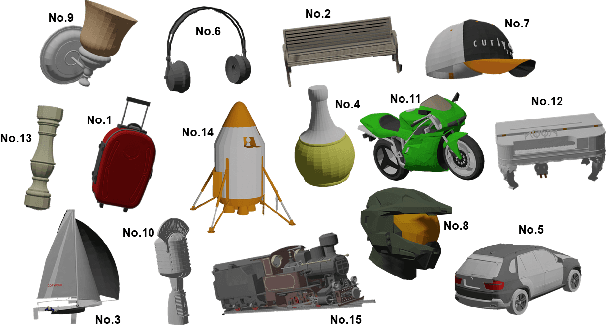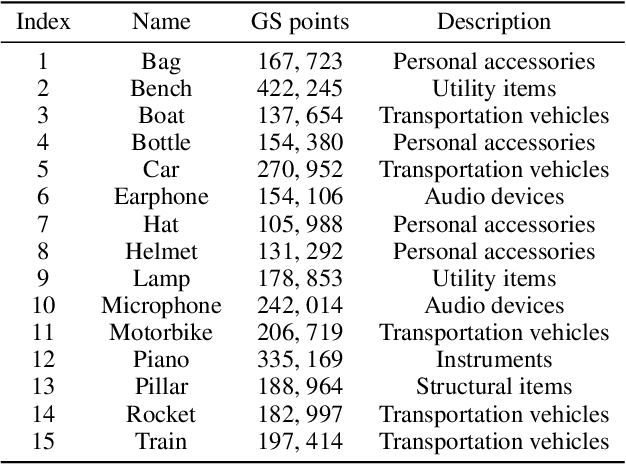Wangmeng Zuo
RoomEditor++: A Parameter-Sharing Diffusion Architecture for High-Fidelity Furniture Synthesis
Dec 19, 2025Abstract:Virtual furniture synthesis, which seamlessly integrates reference objects into indoor scenes while maintaining geometric coherence and visual realism, holds substantial promise for home design and e-commerce applications. However, this field remains underexplored due to the scarcity of reproducible benchmarks and the limitations of existing image composition methods in achieving high-fidelity furniture synthesis while preserving background integrity. To overcome these challenges, we first present RoomBench++, a comprehensive and publicly available benchmark dataset tailored for this task. It consists of 112,851 training pairs and 1,832 testing pairs drawn from both real-world indoor videos and realistic home design renderings, thereby supporting robust training and evaluation under practical conditions. Then, we propose RoomEditor++, a versatile diffusion-based architecture featuring a parameter-sharing dual diffusion backbone, which is compatible with both U-Net and DiT architectures. This design unifies the feature extraction and inpainting processes for reference and background images. Our in-depth analysis reveals that the parameter-sharing mechanism enforces aligned feature representations, facilitating precise geometric transformations, texture preservation, and seamless integration. Extensive experiments validate that RoomEditor++ is superior over state-of-the-art approaches in terms of quantitative metrics, qualitative assessments, and human preference studies, while highlighting its strong generalization to unseen indoor scenes and general scenes without task-specific fine-tuning. The dataset and source code are available at \url{https://github.com/stonecutter-21/roomeditor}.
ProImage-Bench: Rubric-Based Evaluation for Professional Image Generation
Dec 13, 2025Abstract:We study professional image generation, where a model must synthesize information-dense, scientifically precise illustrations from technical descriptions rather than merely produce visually plausible pictures. To quantify the progress, we introduce ProImage-Bench, a rubric-based benchmark that targets biology schematics, engineering/patent drawings, and general scientific diagrams. For 654 figures collected from real textbooks and technical reports, we construct detailed image instructions and a hierarchy of rubrics that decompose correctness into 6,076 criteria and 44,131 binary checks. Rubrics are derived from surrounding text and reference figures using large multimodal models, and are evaluated by an automated LMM-based judge with a principled penalty scheme that aggregates sub-question outcomes into interpretable criterion scores. We benchmark several representative text-to-image models on ProImage-Bench and find that, despite strong open-domain performance, the best base model reaches only 0.791 rubric accuracy and 0.553 criterion score overall, revealing substantial gaps in fine-grained scientific fidelity. Finally, we show that the same rubrics provide actionable supervision: feeding failed checks back into an editing model for iterative refinement boosts a strong generator from 0.653 to 0.865 in rubric accuracy and from 0.388 to 0.697 in criterion score. ProImage-Bench thus offers both a rigorous diagnostic for professional image generation and a scalable signal for improving specification-faithful scientific illustrations.
Language-Guided Graph Representation Learning for Video Summarization
Nov 14, 2025Abstract:With the rapid growth of video content on social media, video summarization has become a crucial task in multimedia processing. However, existing methods face challenges in capturing global dependencies in video content and accommodating multimodal user customization. Moreover, temporal proximity between video frames does not always correspond to semantic proximity. To tackle these challenges, we propose a novel Language-guided Graph Representation Learning Network (LGRLN) for video summarization. Specifically, we introduce a video graph generator that converts video frames into a structured graph to preserve temporal order and contextual dependencies. By constructing forward, backward and undirected graphs, the video graph generator effectively preserves the sequentiality and contextual relationships of video content. We designed an intra-graph relational reasoning module with a dual-threshold graph convolution mechanism, which distinguishes semantically relevant frames from irrelevant ones between nodes. Additionally, our proposed language-guided cross-modal embedding module generates video summaries with specific textual descriptions. We model the summary generation output as a mixture of Bernoulli distribution and solve it with the EM algorithm. Experimental results show that our method outperforms existing approaches across multiple benchmarks. Moreover, we proposed LGRLN reduces inference time and model parameters by 87.8% and 91.7%, respectively. Our codes and pre-trained models are available at https://github.com/liwrui/LGRLN.
Perceptual Quality Assessment of 3D Gaussian Splatting: A Subjective Dataset and Prediction Metric
Nov 11, 2025



Abstract:With the rapid advancement of 3D visualization, 3D Gaussian Splatting (3DGS) has emerged as a leading technique for real-time, high-fidelity rendering. While prior research has emphasized algorithmic performance and visual fidelity, the perceptual quality of 3DGS-rendered content, especially under varying reconstruction conditions, remains largely underexplored. In practice, factors such as viewpoint sparsity, limited training iterations, point downsampling, noise, and color distortions can significantly degrade visual quality, yet their perceptual impact has not been systematically studied. To bridge this gap, we present 3DGS-QA, the first subjective quality assessment dataset for 3DGS. It comprises 225 degraded reconstructions across 15 object types, enabling a controlled investigation of common distortion factors. Based on this dataset, we introduce a no-reference quality prediction model that directly operates on native 3D Gaussian primitives, without requiring rendered images or ground-truth references. Our model extracts spatial and photometric cues from the Gaussian representation to estimate perceived quality in a structure-aware manner. We further benchmark existing quality assessment methods, spanning both traditional and learning-based approaches. Experimental results show that our method consistently achieves superior performance, highlighting its robustness and effectiveness for 3DGS content evaluation. The dataset and code are made publicly available at https://github.com/diaoyn/3DGSQA to facilitate future research in 3DGS quality assessment.
PhysWorld: From Real Videos to World Models of Deformable Objects via Physics-Aware Demonstration Synthesis
Oct 24, 2025Abstract:Interactive world models that simulate object dynamics are crucial for robotics, VR, and AR. However, it remains a significant challenge to learn physics-consistent dynamics models from limited real-world video data, especially for deformable objects with spatially-varying physical properties. To overcome the challenge of data scarcity, we propose PhysWorld, a novel framework that utilizes a simulator to synthesize physically plausible and diverse demonstrations to learn efficient world models. Specifically, we first construct a physics-consistent digital twin within MPM simulator via constitutive model selection and global-to-local optimization of physical properties. Subsequently, we apply part-aware perturbations to the physical properties and generate various motion patterns for the digital twin, synthesizing extensive and diverse demonstrations. Finally, using these demonstrations, we train a lightweight GNN-based world model that is embedded with physical properties. The real video can be used to further refine the physical properties. PhysWorld achieves accurate and fast future predictions for various deformable objects, and also generalizes well to novel interactions. Experiments show that PhysWorld has competitive performance while enabling inference speeds 47 times faster than the recent state-of-the-art method, i.e., PhysTwin.
Tool-R1: Sample-Efficient Reinforcement Learning for Agentic Tool Use
Sep 16, 2025Abstract:Large language models (LLMs) have demonstrated strong capabilities in language understanding and reasoning, yet they remain limited when tackling real-world tasks that require up-to-date knowledge, precise operations, or specialized tool use. To address this, we propose Tool-R1, a reinforcement learning framework that enables LLMs to perform general, compositional, and multi-step tool use by generating executable Python code. Tool-R1 supports integration of user-defined tools and standard libraries, with variable sharing across steps to construct coherent workflows. An outcome-based reward function, combining LLM-based answer judgment and code execution success, guides policy optimization. To improve training efficiency, we maintain a dynamic sample queue to cache and reuse high-quality trajectories, reducing the overhead of costly online sampling. Experiments on the GAIA benchmark show that Tool-R1 substantially improves both accuracy and robustness, achieving about 10\% gain over strong baselines, with larger improvements on complex multi-step tasks. These results highlight the potential of Tool-R1 for enabling reliable and efficient tool-augmented reasoning in real-world applications. Our code will be available at https://github.com/YBYBZhang/Tool-R1.
MoCo: Motion-Consistent Human Video Generation via Structure-Appearance Decoupling
Aug 24, 2025Abstract:Generating human videos with consistent motion from text prompts remains a significant challenge, particularly for whole-body or long-range motion. Existing video generation models prioritize appearance fidelity, resulting in unrealistic or physically implausible human movements with poor structural coherence. Additionally, most existing human video datasets primarily focus on facial or upper-body motions, or consist of vertically oriented dance videos, limiting the scope of corresponding generation methods to simple movements. To overcome these challenges, we propose MoCo, which decouples the process of human video generation into two components: structure generation and appearance generation. Specifically, our method first employs an efficient 3D structure generator to produce a human motion sequence from a text prompt. The remaining video appearance is then synthesized under the guidance of the generated structural sequence. To improve fine-grained control over sparse human structures, we introduce Human-Aware Dynamic Control modules and integrate dense tracking constraints during training. Furthermore, recognizing the limitations of existing datasets, we construct a large-scale whole-body human video dataset featuring complex and diverse motions. Extensive experiments demonstrate that MoCo outperforms existing approaches in generating realistic and structurally coherent human videos.
MDIQA: Unified Image Quality Assessment for Multi-dimensional Evaluation and Restoration
Aug 23, 2025



Abstract:Recent advancements in image quality assessment (IQA), driven by sophisticated deep neural network designs, have significantly improved the ability to approach human perceptions. However, most existing methods are obsessed with fitting the overall score, neglecting the fact that humans typically evaluate image quality from different dimensions before arriving at an overall quality assessment. To overcome this problem, we propose a multi-dimensional image quality assessment (MDIQA) framework. Specifically, we model image quality across various perceptual dimensions, including five technical and four aesthetic dimensions, to capture the multifaceted nature of human visual perception within distinct branches. Each branch of our MDIQA is initially trained under the guidance of a separate dimension, and the respective features are then amalgamated to generate the final IQA score. Additionally, when the MDIQA model is ready, we can deploy it for a flexible training of image restoration (IR) models, enabling the restoration results to better align with varying user preferences through the adjustment of perceptual dimension weights. Extensive experiments demonstrate that our MDIQA achieves superior performance and can be effectively and flexibly applied to image restoration tasks. The code is available: https://github.com/YaoShunyu19/MDIQA.
SelfHVD: Self-Supervised Handheld Video Deblurring for Mobile Phones
Aug 12, 2025Abstract:Shooting video with a handheld mobile phone, the most common photographic device, often results in blurry frames due to shaking hands and other instability factors. Although previous video deblurring methods have achieved impressive progress, they still struggle to perform satisfactorily on real-world handheld video due to the blur domain gap between training and testing data. To address the issue, we propose a self-supervised method for handheld video deblurring, which is driven by sharp clues in the video. First, to train the deblurring model, we extract the sharp clues from the video and take them as misalignment labels of neighboring blurry frames. Second, to improve the model's ability, we propose a novel Self-Enhanced Video Deblurring (SEVD) method to create higher-quality paired video data. Third, we propose a Self-Constrained Spatial Consistency Maintenance (SCSCM) method to regularize the model, preventing position shifts between the output and input frames. Moreover, we construct a synthetic and a real-world handheld video dataset for handheld video deblurring. Extensive experiments on these two and other common real-world datasets demonstrate that our method significantly outperforms existing self-supervised ones. The code and datasets are publicly available at https://github.com/cshonglei/SelfHVD.
Enhanced Generative Structure Prior for Chinese Text Image Super-resolution
Aug 11, 2025Abstract:Faithful text image super-resolution (SR) is challenging because each character has a unique structure and usually exhibits diverse font styles and layouts. While existing methods primarily focus on English text, less attention has been paid to more complex scripts like Chinese. In this paper, we introduce a high-quality text image SR framework designed to restore the precise strokes of low-resolution (LR) Chinese characters. Unlike methods that rely on character recognition priors to regularize the SR task, we propose a novel structure prior that offers structure-level guidance to enhance visual quality. Our framework incorporates this structure prior within a StyleGAN model, leveraging its generative capabilities for restoration. To maintain the integrity of character structures while accommodating various font styles and layouts, we implement a codebook-based mechanism that restricts the generative space of StyleGAN. Each code in the codebook represents the structure of a specific character, while the vector $w$ in StyleGAN controls the character's style, including typeface, orientation, and location. Through the collaborative interaction between the codebook and style, we generate a high-resolution structure prior that aligns with LR characters both spatially and structurally. Experiments demonstrate that this structure prior provides robust, character-specific guidance, enabling the accurate restoration of clear strokes in degraded characters, even for real-world LR Chinese text with irregular layouts. Our code and pre-trained models will be available at https://github.com/csxmli2016/MARCONetPlusPlus
 Add to Chrome
Add to Chrome Add to Firefox
Add to Firefox Add to Edge
Add to Edge